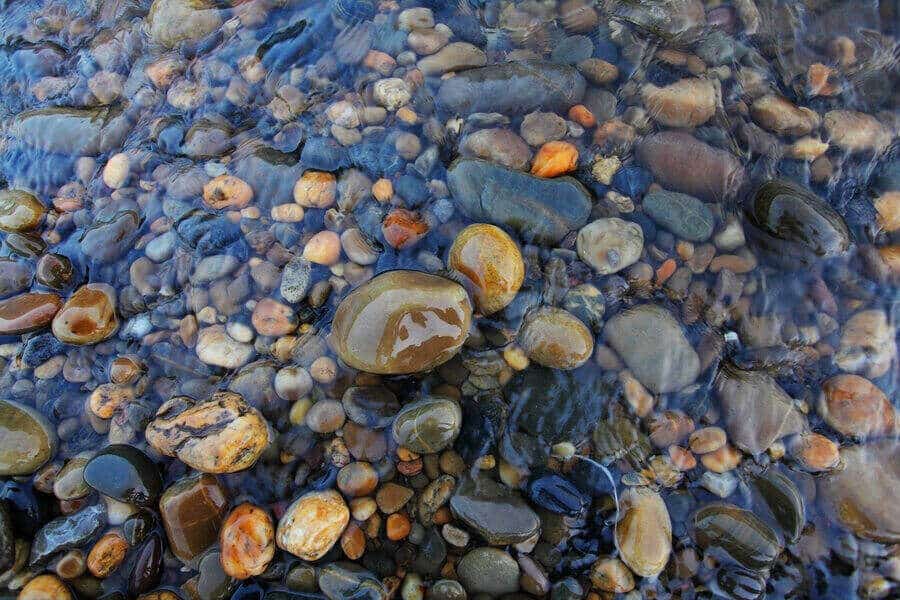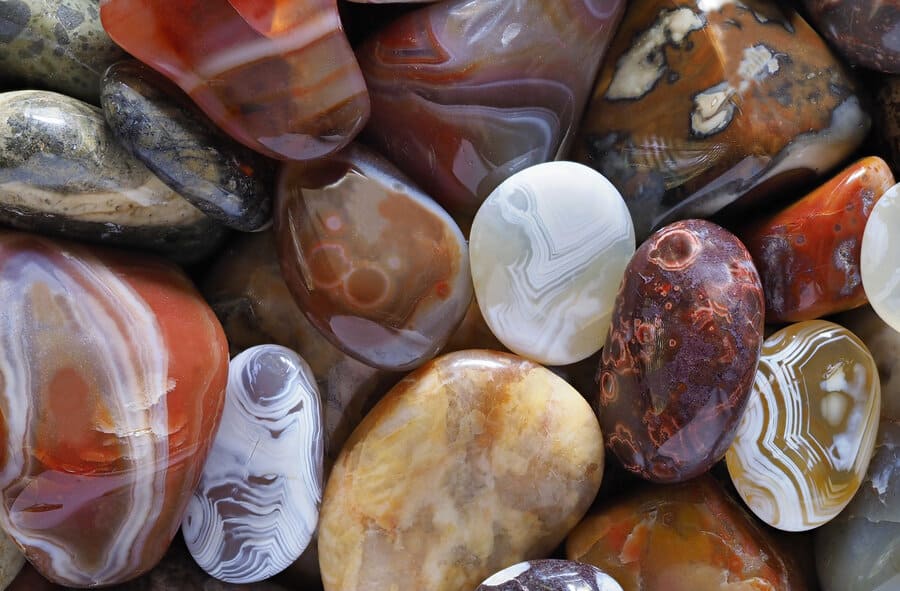
Spending time along a river can be a fun and relaxing way to spend time outdoors and take in the sights. The running water, wildlife, and even the rocks all add something to the scene. One of my daughter’s favorite activities is collecting rocks and seashells from the banks of a nearby river at a park close to our house. During one of our recent trips to the river, she asked me why all of the rocks in the river are smooth and round. I’m sure at some point you have asked yourself that same question.
River rocks tend to be smooth and round because of a combination of the geologic processes of erosion and weathering. Rocks are eroded from surrounding areas and are initially rough and jagged, but over many years they are weathered via transport-induced abrasion to become smooth and rounded.
While the basic principles of erosion and weathering and easy enough to understand, the actual process by which river rocks become smooth and round is quite a bit more complicated than you might think. The length of time it takes to reach that state can vary quite a bit depending on factors like the type of rock and the energy levels of the surrounding water. Scientists have managed to come up with some clever models and formulas to describe the rounding and smoothing process. I’ll explain this process in more detail, and give you some ideas on how to observe this process in your own home.
Why River Rocks are Smooth and Round
It’s no coincidence that most of the rocks you see in and around rivers tend to be smooth and round. Over many years, the rocks in the river are shaped by the natural forces in the river to create the rounded, smooth rocks you see today. This process is known as weathering, and there are several contributing factors at play in the river that make it work. Most of the shaping is done through the process of abrasion, and it is complemented by some chemical weathering. Of course, before any of this can happen, it has to get into the river first.
How Rocks Get into Rivers
Virtually all of the rocks that you currently see in a river have been transported there from somewhere else. They began their journey somewhere upriver, likely many miles from where they reside today. They were once part of a larger mass of rock and were eventually dislodged. This process is known as erosion, and it’s where a rock’s journey downriver begins.
After a rock has been dislodged from its former home, it becomes increasingly subject to the natural forces of wind and water. Over many years, the rock is washed downhill into stream beds and eventually into a river. As soon as a rock begins its journey the rounding and smoothing processes begin.
What Happens to a Rock in a River?
Once a rock enters a river, it begins to be transported by the relentless, powerful currents of the running water. During this time the rock is being rolled around as it moves, banging against other rocks and suffering damage with each impact. The impact between the rock and other rocks or the riverbed is the dominant force contributing to its rounding and smoothing. Little bits of the rock break off or are scratched off with every impact, and overall that breaking and chipping add up to a rounded shape. The scientific term for this physical process is transport-induced abrasion, which simply means that as the rock is being moved it is rubbing against other hard surfaces, causing damage.
The reason the rock tends to become more well-rounded with each impact is that any points or edges are more likely to take the force of the impact than a flat surface. The more pronounced a point or an edge, the more likely it is to be the point that makes contact with another hard surface as the rock is tumbling around. In addition, those more exposed points are also weaker than the main body of the rock and are therefore more prone to damage. As the rock becomes more rounded the impacts become more evenly distributed over its surface.
Why Are River Rocks Slippery?
You might be thinking that all of this explains why the rocks are round, but why are they so smooth – even to the point of being slippery? In addition to the impacts and abrasions a rock endures on its journey downriver, it is also constantly being bombarded by the water and sediments in the river. Over many years, these near-constant forces are enough to make the surface of a rock almost completely smooth to the touch.
As rocks are being broken down in the running water, the little fragments of rock enter the river as sediment. The faster a river runs, the more sediment load it can carry. An enormous amount of sediment can be moved along in a river, and those little bits of rock are constantly rubbing against the surface of the larger rocks in the river. You can think of this as the rocks being sandblasted with little bits of themselves. These little bits of sediment slowly but surely wear away at the surface of the larger rocks, eventually making them very smooth.
Why do Rocks Get Smaller Downstream?
You may have noticed that rocks further downriver tend to be smaller than those upriver. As rocks continue along their journey downriver, the processes I’ve described above to continue to act upon them. Even after they are well-rounded and smooth, the rocks remain subject to the abrasive weathering that made them that way.
Rocks get smaller downstream because as they have had more time to be subjected to the weathering process. As the rocks are transported downriver they are worn down, gradually reducing in size. In addition, a slow-moving river lacks the energy to carry larger rocks downriver.
Can I Take Rocks from a River?
If you’re spending some time by a river and enjoying the rocks on display, it’s natural to wonder if you can take some home with you. Unfortunately, it’s not always clear whether or not this is allowed. Whether or not you are allowed to take rocks from the river is almost entirely dependent on what type of land you are on.
As a general rule, you can take rocks from a river on BLM or National Forest land, while taking rocks from National Parks is strictly forbidden. For rivers on private land, permission must be obtained from the landowner in order to collect any rocks. State-owned land will vary from state to state.
Tip: For an in-depth breakdown on rockhounding laws and regulations, check out my article on the subject.
Can I Tumble River Rocks?

The natural forces that rocks undergo in a river take years and years to create the nicely rounded and smooth rocks you so commonly see in a riverbed. But we have invented a way to speed this process up and get that time down to a matter of weeks. Rock tumbling is a fantastic hobby that reveals the beauty hiding inside rocks, even some that seem otherwise mundane or boring. It is extremely rewarding to tumble and polish a batch of rocks which you have collected yourself.
Tip: Check out my Complete Guide to Rock Tumbling and become a rock tumbling pro in no time
As a general rule, you can tumble river rocks as long as they are hard enough and they don’t have a gritty texture. Extra time should usually be spent in the first phase of the tumbling process in order to remove any bruising or cracks that the river rocks may have endured. For a complete breakdown of what kind of rocks are suitable for tumbling, see my article here.
